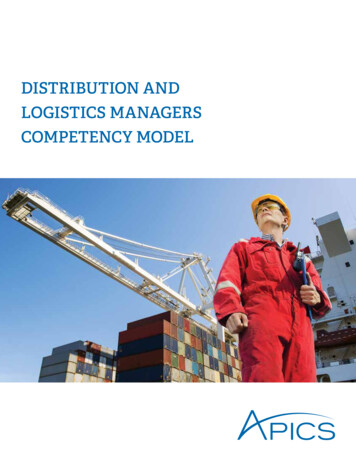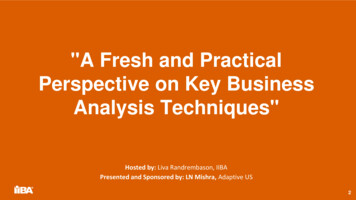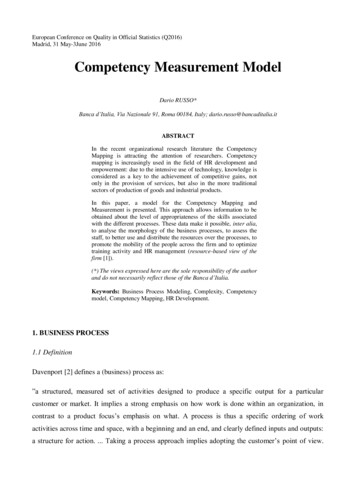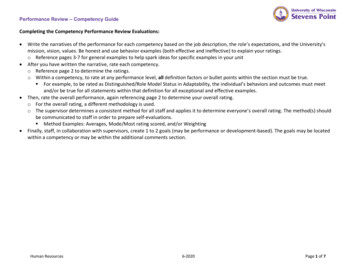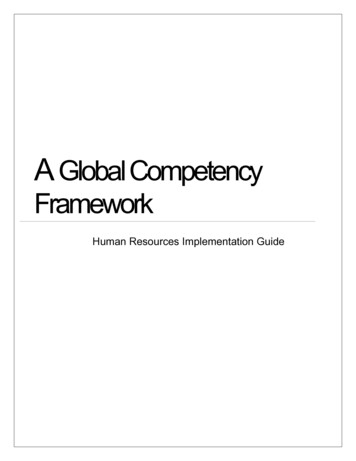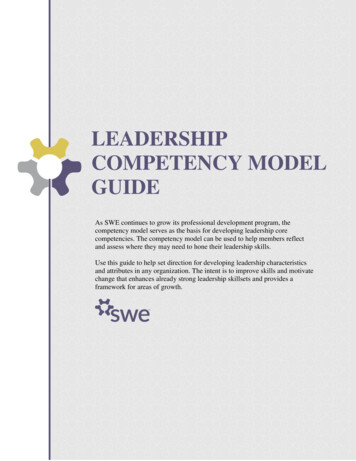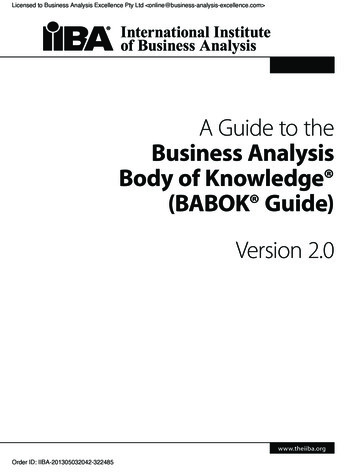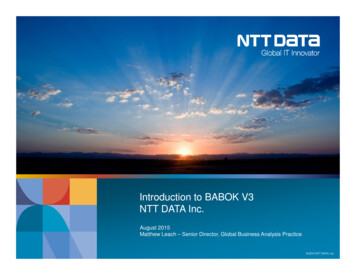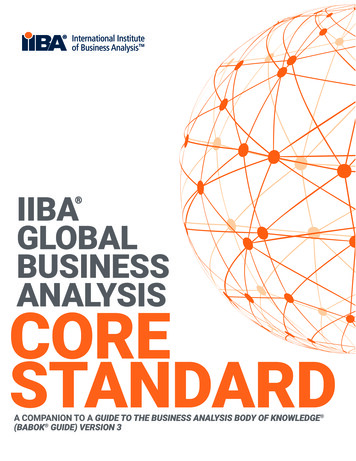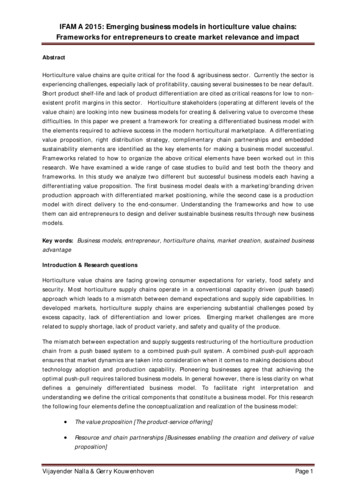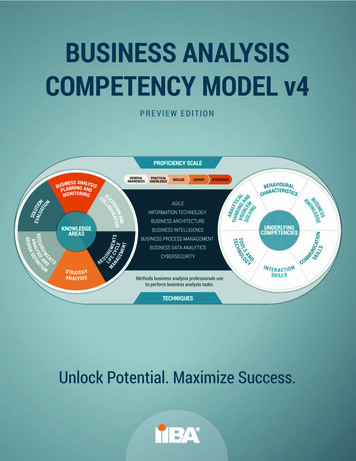
Transcription
Business AnalysisCompetency Model v4PREVIEW EDITION
International Institute of Business Analysis, Toronto, Ontario, Canada. 2010, 2011, 2017. 2020 International Institute of Business Analysis. All rights reserved.This Business Analysis Competency Model is not for distribution, digital transmission, resale, orreproduction in whole or part.Version 1.0 published 2008. Version 2.0 published 2010. Version 3.0 published 2011. Version4.0 published 2017.This document is provided to the business analysis community for educational purposes. IIBA does not warrant that it is suitable for any other purpose and makes no expressed or impliedwarranty of any kind and assumes no responsibility for errors or omissions. No liability isassumed for incidental or consequential damages in connection with or arising out of the use ofthe information contained herein.IIBA , the IIBA logo, BABOK and Business Analysis Body of Knowledge and Business AnalysisCompetency Model are registered trademarks owned by International Institute of BusinessAnalysis. CBAP is a registered certification mark owned by International Institute of BusinessAnalysis. Certified Business Analysis Professional, EEP and the EEP logo are trademarks ownedby International Institute of Business Analysis.No challenge to the status or ownership of these or any other trademarked terms containedherein is intended by the International Institute of Business Analysis.Any inquiries regarding this publication, requests for usage rights for the material includedherein, or corrections should be sent by email to bok@iiba.org.
Table of ContentsChapter 1: Introduction1.11.21.31.41.51.6About this guide 1What is a Competency Model? 1Understanding the Model 3Who should use the Competency Model? 4How to use the competency model 5Copyright, Licensing, and Contact Information 6Chapter 2: Proficiency Levels LegendThe Business Analysis Competency Model (Comprehensive Edition) includes the followingadditional content:Chapter 3: Business Analysis Planning and Monitoring3.1Plan Business Analysis Approach3.2Plan Stakeholder Engagement3.3Plan Business Analysis Governance3.4Plan Business Analysis Information Management3.5Identify Business Analysis Performance ImprovementsChapter 4: Elicitation and Collaboration4.1Prepare for Elicitation4.2Conduct Elicitation4.3Confirm Elicitation Results4.4Communicate Business Analysis Information4.5Manage Stakeholder Collaborationi
Table of ContentsChapter 5: Requirements Life Cycle Management5.1Trace Requirements5.2Maintain Requirements5.3Prioritize Requirements5.4Assess Requirements Changes5.5Approve RequirementsChapter 6: Strategy Analysis6.1Analyze Current State6.2Define Future State6.3Assess Risks6.4Define Change StrategyChapter 7: Requirements Analysis and Design Definition7.1Specify and Model Requirements7.2Verify Requirements7.3Validate Requirements7.4Define Requirements Architecture7.5Define Design Options7.6Analyze Potential Value and Recommend SolutionChapter 8: Solution Evaluation8.1Measure Solution Performance8.2Analyze Performance Measures8.3Assess Solution Limitations8.4Assess Enterprise Limitations8.5Recommend Actions to Increase Solution ValueAppendix A: Underlying CompetenciesA.1Analytical Thinking and Problem SolvingA.2Behavioural CharacteristicsA.3Business KnowledgeA.4Communication SkillsA.5Interaction SkillsA.6Tools and TechnologyAppendix B: Glossaryii
PrefaceIIBA was founded in Toronto, Canada in October of 2003 to support the business analysiscommunity by: creating and developing awareness and recognition of the value and contribution of thebusiness analyst, defining the Business Analysis Body of Knowledge (BABOK ), providing a forum for knowledge sharing and contribution to the business analysis profession,and publicly recognizing and certifying qualified practitioners through an internationallyacknowledged certification program.This document is provided to the business analysis community for educational reference andresearch. IIBA does not warrant that it is suitable for any other purpose and makes no expressedor implied warranty of any kind and assumes no responsibility for errors or omissions. No liability isassumed for incidental or consequential damages in connection with or arising out of the use of theinformation contained herein.The goal of this revision (version 4) was to: modernize the Business Analysis (BA) Competency Model based on industry best practices fordevelopment of Competencies, streamline the assessment points, integrate behavioral indicators to include skill level, business analysis expertise e.g. tasks andtechniques and underlying competencies, align it to BABOK Guide v3.0 – the standard for Business Analysis, align it to the new 4-Level Certification Framework, to deliver a path for BA practitioner growth,focus on its practical application to the BA Practitioner, and position it as the leading resource for competency development among BA practitioners.The major changes in this release include: a new five-point scale and descriptions to indicate proficiency levels for assessment, a decrease of assessment points (performance competencies) from over three hundred tothirty, and the embedding of common techniques and underlying competencies within each of the thirtyperformance competencies.v
1Introduction1.1About this guideThe Business Analysis Competency Model version 4 identifies thebehaviours and techniques associated with each level of business analysis, toassist readers in understanding the levels of competency in the businessanalysis profession.This guide supports the four levels of IIBA's Multi-level Competency-BasedCertification program by highlighting the key competency componentsassociated with each business analysis task. This will allow professionals toidentify areas of focus to promote professional development in businessanalysis.1.2What is a Competency Model?A competency model is a framework for defining knowledge, skills, abilities,techniques, and personal characteristics that together define successfulperformance in a work setting, in any chosen profession.Competency models are the foundation for important human resourcefunctions such as recruitment and hiring, training and development, andperformance management.Competency models are also developed for specific jobs, job groups,organizations, occupations, or industries to help evaluate and grow careers.To be effective, a competency model must both define the characteristicsnecessary for success and indicators that can be used to assess if individualsdisplay that competency on the job.1
IntroductionWhat is a Competency Model?BUSINESS ANALYSIS COMPETENCY MODELThe Competency Model assesses understanding of business foundational skills, tasks, techniques,and personal characteristics necessary to perform as a business analyst on a 5 pointRTQƒEKGPE[ UECNG 6JG RTQƒEKGPE[ NGXGNU CTG TGEQIPK\GF D[ #ŨU /WNVK .GXGN %QORGVGPE[ CUGF %GTVKƒECVKQP RTQITCO PROFICIENCY SCALEQLI U IRFE E MAN C Y E N T SAG C L EEME NTRES T R AT E G YA N A LY S I SEXPERTSTRATEGISTINFORMATION TECHNOLOGYBUSINESS ARCHITECTUREANATHIN LYTICKPRO ING A ALSOL BLEM NVINGDAGILEUNDERLYINGCOMPETENCIESBUSINESS INTELLIGENCEBUSINESS PROCESS MANAGEMENTBUSINESS DATA MMethods business analysis professionals useto perform business analysis tasks.KINTER A CTIO NS KIL L SMUS K N IC AI L L TIO NSECO LLSKILLEDAN GLS OTO O NOLTECHEM NIR E AR E Q U LY SI S INITA N A DEFND E SIGNTD SIONKNOWLEDGEAREASPRACTICALKNOWLEDGEESSSIN DGEBU WLENONGENERALAWARENESSDN ANTIO TIONITA RAIC ABOLSOEVAL LUTIOUA NTI OINESS ANALYBUS ANNING AN SISDPLMONITORINGCOMTECHNIQUESTechniques are methods business analysis professional use to preform business analysis tasks. Thetechniques described in the BABOK Guide are intended to cover the most common and widespreadtechniques practiced within the business analysis community.KNOWLEDGE AREASUNDERLYING COMPETENCIES6JG UKZ MPQYNGFIG CTGCU TGRTGUGPV CTGCU QH URGEKƒE DWUKPGUU CPCN[UKU GZRGTVKUG VJCV GPEQO pass several tasks.The Business Analysis Competency Model helps illustrate how A Guide to theBusiness Analysis Body of Knowledge (BABOK Guide) Knowledge Area are related to the Un derlying Competencies and to the BABOK Guide Techniques. Each Knowledge Area is held upby all of the Underlying Competencies, which are supported by the BABOK Guide Techniques.Solution Evaluation: This knowledge areadescribes the tasks that business analystsperform to: Assess the performance of and valuedelivered by the enterprise Recommend removal of barriersor constraints that prevent the fullrealization of the valueBusiness Analysis Planning and Monitoring:This knowledge area describes the tasks thatbusiness analysis professionals perform toorganize and coordinate the efforts of businessanalysis professionals and stakeholders.Requirements Analysis and Design Definition:This knowledge area describes: The tasks that business analysisprofessionals perform to preparefor and conduct elicitation activitiesCPF EQPƒTO TGUWNVU QDVCKPGF The communication withstakeholders that happens once thebusiness analysis information isassembled The ongoing collaboration withstakeholders throughout thebusiness analysis activities.4GSWKTGOGPVU .KHG %[ENG /CPCIGOGPV This knowledge area describes the tasksthat business analysis professionalsperform in order to manage and maintainrequirements and design information frominception to retirement.Strategy Analysis: This knowledge areadescribes the business analysis work thatmust be performed to collaborate with thestakeholders in order to: Identify a need of strategic or tacticalimportance (the business need) Enable the enterprise to address thebusiness need Align the resulting strategy for thechange with higher- and lower-levelstrategies'NKEVCVKQP CPF %QNNCDQTCVKQP This knowledgearea describes the tasks that businessanalysis professionals perform to: Structure and organize requirementsdiscovered during elicitation activities Specify and model requirements anddesigns Validate and verify information Identify solution options that meetbusiness needs Estimate the potential value that couldbe realized for each solution option.2Underlying Competencies provide a description of the behaviours, characteristics,knowledge, and personal qualities that support the effective practice of business analysis.Analytical Thinking and Problem Solvingskills are required for business analyststo analyze problems and opportunitieseffectively, identify which changes maydeliver the most value, and work withstakeholders to understand the impactof those changes.Business Knowledge is required for thebusiness analyst to perform effectivelywithin their business, industry, organization, solution, and methodology. Businessknowledge enables the business analystto better understand the overarchingconcepts that govern the structure,benefits, and value of the situation as itrelates to a change or a need.Interaction Skills are represented bythe business analyst’s ability to relate,cooperate, and communicate withdifferent kinds of people including executives, sponsors, colleagues, team members,developers, vendors, learning and development professionals, end users, customers,and subject matter experts (SMEs).Behavioral Characteristics have been foundto increase personal effectiveness in thepractice of business analysis. These characteristics exist at the core of every businessanalyst’s skill set. Each behavioral characteristic e.g. ethics, personal accountability,trustworthiness, organization and time management and adaptability, can impact theoutcome of the practitioner’s efforts.Communication is the act of a senderconveying information to a receiver in amethod which delivers the meaning thesender intended. Active listening skillshelp to deepen understanding and trustbetween the sender and the receiver. EffectiveEQOOWPKECVKQP DGPGƒVU CNN UVCMGJQNFGTU Tools and Technology: Business analystsuse a variety of software applications tosupport communication and collaboration, create and maintain requirementsartifacts, model concepts, track issues,and increase overall productivity.Learn more at: https://go.iiba.org/BA-Competency-Model
IntroductionUnderstanding the Model1.3Understanding the Model1.3.1Key ConceptsCompetency is the successful application of knowledge, skills, abilities, andproficiency descriptors that are expected from individuals as they progresstheir careers.Experience in these areas grows as the knowledge and techniques areapplied in a variety of contexts and situations.1.3.2Knowledge AreasKnowledge Areas (KAs) from the BABOK Guide version 3.0 (Chapters 3 - 8).1.3.3Performance CompetenciesThirty performance competencies are the base of this model, categorized byBABOK Guide Knowledge Areas.1.3.4Underlying CompetenciesUnderlying Competencies, the skills, knowledge and personal characteristicsthat support the effective performance of business analysis, are defined inChapter 9 of the BABOK Guide.1.3.5TasksA Task is an essential piece of business analysis work that must be performedas part of business analysis. Each Task should be performed at least onceduring the vast majority of business analysis initiatives. Tasks are definedwithin each Knowledge Area of the BABOK Guide.1.3.6TechniquesTechniques are different ways that a Task may be performed. Techniques aredefined in Chapter 10 of the BABOK Guide.1.3.7Proficiency DescriptorsThe Proficiency Descriptors of the Business Analysis Competency Model arederived from the Knowledge Areas and Underlying Competencies as listed inthe BABOK Guide v3.3
IntroductionWho should use the Competency Model?These describe the behaviours the business analysis professionaldemonstrates, drawing on his or her knowledge, skills and experience in thecompetency.1.4Who should use the Competency Model?The Business Analysis Competency Model is a research and reference guidedesigned to equip BA professionals with the information needed tocontinuously develop skills in real-time, in order to meet the needs oforganizations.This model can be used by anyone involved directly or indirectly in theBusiness Analysis (BA) profession, regardless of their official job role or title.The usage and value for differing roles can be generally summarized asfollows: Business Analysis Professionals Business Analysis Manager/Team Leads Human Resources Professionals1.4.1Business Analysis ProfessionalsBusiness Analysis Professionals can use this guide to: apply the six knowledge areas (KAs) from A Guide to the Business AnalysisBody of Knowledge (BABOK Guide) v3. (chapters 3-8), in the context ofBA roles and responsibilities performed at all levels of the profession, understand and assess business analysis skill levels against the thirtyperformance competencies and the different techniques used todemonstrate them, recognize the necessary behavioral indicators that are tied to thedevelopment and demonstration of underlying competencies from theBABOK Guide (chapter 9), to further career development.The Competency Model helps BA Professionals to: identify the skills, knowledge and behavioral characteristicsdemonstrated at all levels of the BA Profession, and track where they are in their career and provide the information necessaryto grow in the profession.1.4.2Business Analysis Manager/Team LeadsBusiness Analysis Managers and Team Leads can use this guide to: understand the different levels of BA performance within their team, identify and assess a skills gap amongst individual BA team membersagainst the performance competencies, techniques, and key behavioralindicators needed to perform successful on the job, and4
IntroductionHow to use the competency model facilitate career planning discussions with individual BA team members toassist them with further career development.The Competency Model helps Business Analysis Managers and Team leadsto: understand what to expect when hiring a General Awareness, PracticalKnowledge, Skilled, Expert or Strategist Level BA, and identify the skills and knowledge gaps of the BA Professional at theselevels, to facilitate ongoing performance management, mentoring,coaching and career planning discussions.1.4.3Human Resource ProfessionalsHuman Resources Professionals can use this guide to: research role gaps and perform deeper assessments to align roles perindustry trends and benchmarks, and assist in the recruitment efforts to hire the right skilled level BAProfessionals.The Competency Model helps Human Resource Professionals to: assess training gaps with BA Management, hire the right BA Professionals, understand the value the BA Professional offers, and elevate the BA Professional as a leader within the organization.1.5How to use the competency modelUsers of the Competency Model may consider the following guidance todetermine the best utilization:1.Review the BABOK Guide Knowledge Area tasks, as listed in this guide.2. In each task's Proficiency Descriptors section, self-assess yourselfagainst the 5-pt scale (General Awareness to Strategist).3. Review the next level of Proficiency Descriptors to assess what traitsyou will need to demonstrate to move to the level.4. Consider the Common Techniques for each Knowledge Area task tounderstand how to apply them in performance of the tasks.5
IntroductionCopyright, Licensing, and Contact Information1.6Copyright, Licensing, and Contact Information1.6.1Copyright InformationInternational Institute of Business Analysis (IIBA ), Toronto, Ontario,Canada. 2017 International Institute of Business Analysis (IIBA ). All rightsreserved.This Business Analysis Competency Model is not for distribution, digitaltransmission, resale, or reproduction in whole or part.This document is provided to the business analysis community foreducational purposes. IIBA does not warrant that it is suitable for any otherpurpose and makes no expressed or implied warranty of any kind andassumes no responsibility for errors or omissions. No liability is assumed forincidental or consequential damages in connection with or arising out of theuse of the information contained herein.IIBA , the IIBA logo, BABOK Guide, Business Analysis Body of Knowledge ,and Business Analysis Competency Model are registered trademarks ownedby International Institute of Business Analysis. CBAP and CCBA areregistered trademarks owned by International Institute of BusinessAnalysis . Certified Business Analysis Professional, ECBA , EEP and the EEPlogo are trademarks owned by International Institute of Business Analysis.No challenge to the status or ownership of these or any other trademarkedterms contained herein is intended by the International Institute of BusinessAnalysis.Any inquiries regarding this publication should be sent by email toinfo@iiba.org.1.6.2Licensing and Permissions.1 IIBA Member and Purchased Copy PermissionsA member copy of the Business Analysis Competency Model allows an IIBAmember in good standing a personal use license, which grants permission touse the Competency Model for personal career and competency developmentpurposes only. Members are not allowed to copy, reproduce (in part or whole)or share with others without explicit and written permission from the IIBA.Permission is granted to reproduce this document for your own personal,professional or educational use only. IIBA members and individuals may nottransfer ownership of their complimentary copy. IIBA owns the copyrights tothis material and international copyright law applied to this publication.6
IntroductionCopyright, Licensing, and Contact Information.2 Corporate Usage PermissionsUsing the Business Analysis Competency Model in a corporate ororganizational setting requires a license from IIBA .Organizations may purchase a corporate license to the Business AnalysisCompetency Model for enterprise wide usage internal to their team ororganization. The corporate license enables organizations and teams ofBusiness Analysis Practitioners to share the Business Analysis CompetencyModel and use it within the team and corporate setting. The corporatelicense allows organizations to post the model internally, and tailor or modifythe model to their organization in accordance with the terms and conditionsof the license agreement. Corporate members of IIBA are also eligible for adiscount on the corporate license.1.6.3Contact InformationFor more information on licensing the Business Analysis Competency Model in a corporate or team setting, please refer to the license agreement signedand agreed upon by your organization and the IIBA.For any questions about the content of the Business Analysis CompetencyModel , please contact info@iiba.org.7
2Proficiency Levels LegendThe following table lists the five levels of proficiency, and providesdescriptors for each.Table 2.0.1: Proficiency Levels LegendRatingLabelDescription5StrategistSomeone who: challenges the status quo to develop innovativesolutions that help advance business analysis as adiscipline, practice or profession, and helps expand business analysis concepts andpractices.4ExpertThe Expert level describes someone who: addresses any challenge or opportunity,regardless of level of complexity, finds a way to deliver business value for anychange challenge, guides and mentors others in order to help themdeliver better business outcomes, is sought after for expertise and guidance inaddressing business challenges, and provides insight to situations that fall within (oroutside of) the sphere of influence.8
Proficiency Levels LegendTable 2.0.1: Proficiency Levels Legend (Continued)RatingLabelDescription3SkilledThe Skilled level describes someone who: successfully completes straight-forward tasks andsmaller, well-scoped challenges independently,and identifies appropriate actions and modifiesguidelines that have been provided to address achallenge.2PracticalKnowledgeThe Practical Knowledge level describessomeone who: needs and follows rules and guidelines to performtasks, adheres to prescribed ways to work in order toexecute activities related to the competency, and recognizes the key elements of the competencyand why they are important.1GeneralAwarenessThe General Awareness level describessomeone who: has a fundamental awareness and understandingof basic skills and knowledge involved in thecompetency.9
Techniques are methods business analysis professional use to preform business analysis tasks. The techniques described in the BABOK Guide are intended to cover the most common and widespread techniques practiced within the business analysis community. The Competency Model assesses understanding of business
